| When you create joints, the bones appear automatically between the joints. The order in which you create joints is important: The first joint that's created resides at the top of the hierarchy; the second joint is parented to the first (making it a child of that joint and forcing it to follow the parent's movement); the third is parented to the second; and so on down the line. A joint is like a pivot point in a hierarchy. You can't take a joint's pivot point away; the joint always remains with its pivot point. A joint's position in the hierarchy determines which joints will rotate with it: The joints below it rotate with that joint; the joints above it are not affected by that joint's movements. Don't confuse this hierarchy with joints that are above or below each other physically: One joint can be above another in the Y direction but below it within the hierarchy. To create joints: 1. | From the Skeleton menu, select Joint Tool.
| 2. | In the Side view, click to place the joint. You should generally use an orthographic view when you create joints (Figure 10.4).
Figure 10.4. A joint is created in an orthographic view by selecting Skeleton > Joint Tool. 
| 3. | Click where you want the next joint to be placed.
A bone appears between the two joints (Figure 10.5).
Figure 10.5. The second joint is created. A bone appears between the two joints, demonstrating that they are parented together. The bone is thicker at the parent joint than at the child joint. 
| 4. | Click and drag to place the third joint. When you release the mouse button, the joint will be placed.
| 5. | Press  . .
The skeleton is complete, and you're no longer in the Joint tool. The top joint of the hierarchy is selected, which causes the whole skeleton to be highlighted.
|
 Tips Tips
It's often a good idea to build a skeleton with grid snap turned on so that all your joints are securely aligned. A convenient way to do this is by holding down  when you place joints. when you place joints. You can make the joints appear bigger or smaller by selecting Display > Joint Size and choosing a size from the list. To delete a joint, select the joint and then press  . That joint will be deleted, along with any joints below it in the hierarchy. . That joint will be deleted, along with any joints below it in the hierarchy.
Often you'll want to branch off from a joint in the hierarchy. For example, both arms branch off from the chest joint. To branch off from an existing skeleton: 1. | Using the skeleton from the previous task, "To create joints," click the Joint tool icon  . .
| 2. | Click the joint from which you want to branch off.
This will select the joint, not create a new one.
| 3. | Click where you want the new joint to be placed.
A new joint appears with the bone branched off from the original skeleton (Figure 10.6).
Figure 10.6. A new joint branches off from the existing joints. 
| 4. | From the Window menu, select Hypergraph to view the resulting hierarchy.
Note that two joints are at the same level in the hierarchy, both parented under the same joint (Figure 10.7).
Figure 10.7. Joint3 and joint4 are both children of joint2. That means that if joint2 is rotated, joint3 and joint4 will rotate with it. 
|
You can think of bones as a visual representation of your skeleton's joint hierarchy. When you parent one joint to another, a bone appears. If you unparent a joint, the bone disappears. Sometimes it's easier to create separate hierarchies and then place them inside a single skeleton by parenting them. To parent joints: 1. | Create the skeleton of a leg and foot out of five joints in the Side view (Figure 10.8).
Figure 10.8. This is a typical leg skeleton. Starting from the top, the joints are named hip, knee, ankle, ball, and toe. If the character is wearing shoes, you don't need bones for each toe; one bone is sufficient to rotate the front of the shoe. 
Press  to complete the creation. to complete the creation.
| 2. | As a separate hierarchy, create spine joints in the Side view, starting from the bottom and working your way up (Figure 10.9).
Figure 10.9. A spine joint is created from the bottom up. This makes the bottom joint the parent of the rest of the spine. The rest of the joints are beneath it in the hierarchy even though they are above it in space. 
| 3. | In the Front view, move the leg to the side.
| 4. | Select the top joint of the leg and then  -select the bottom joint of the spine. Now press -select the bottom joint of the spine. Now press  . .
A bone appears between the leg and the spine. It is now one hierarchy (Figure 10.10).
Figure 10.10. The leg has been parented to the spine. Now the bottom joint of the skeleton is the root joint for the whole character. When this joint is moved, the whole character moves. 
|
 Tip Tip
To save time, once you create a leg or arm, you can mirror the joint, which makes a duplicate leg or arm appear on the other side of the body. To mirror joints: 1. | Using the leg from the previous task, "To parent joints," select the hip joint (Figure 10.11).
Figure 10.11. The hip joint is selected so that the leg can be mirrored over to the other side. 
| 2. | From the Skeleton menu, select the box next to Mirror Joint.
The Mirror Joint Options dialog box opens.
| 3. | For Mirror Across, select YZ (Figure 10.12).
Figure 10.12. The YZ option is chosen so that the leg will mirror across the YZ plane. 
| 4. | Click Mirror.
A new leg appears on the other side (Figure 10.13).
Figure 10.13. The opposite leg is created using the Mirror Joint Options dialog box from the Skeleton menu. 
|
 Tips Tips
If the leg was built in the Side view, you should mirror it across the YZ plane. To figure out which plane you should use, look at the view axis in the corner of the panel and imagine two of the axes forming a plane that you want to mirror across. If the new leg does not appear in the correct location, undo the mirror joint and try choosing a different plane to mirror across in the Mirror Joint Options dialog box. Don't mirror a joint that falls on the center line of the body: If you do, you'll end up with two joints on top of each other.
When you move a joint to position it, all of the joints beneath it in the hierarchy move along with it. You can move a joint independently of its position in the hierarchy by using pivot move mode. To move a joint: 1. | Create a skeleton like the one from the previous tasks.
| 2. | Select the knee joint (Figure 10.14).
Figure 10.14. The knee joint of the leg has been selected so that it can be moved. 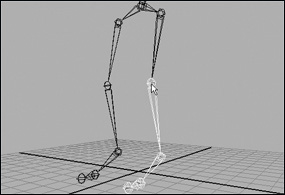
| 3. | Press  . .
| 4. | Move the knee backward.
The rest of the leg moves with it (Figure 10.15).
Figure 10.15. As the knee is moved back, the foot bones move with it. Note that the bone between the hip and the knee becomes longer. 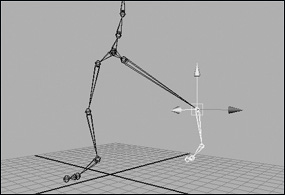
| 5. | Press  to undo the last move. to undo the last move.
| 6. | Press  / / on the keyboard. on the keyboard.
You are now in pivot move mode.
| 7. | Move the knee forward.
The rest of the leg does not move with it (Figure 10.16).
Figure 10.16. When the knee joint is moved in pivot move mode, the foot, which is below it in the hierarchy, stays put. 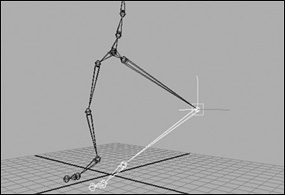
| 8. | Press  to undo the last move. Press to undo the last move. Press  / / again to get out of pivot move mode. again to get out of pivot move mode.
|
To insert a joint: 1. | Create a skeleton of several joints (Figure 10.17).
Figure 10.17. A skeleton of several joints is created in an orthographic view. 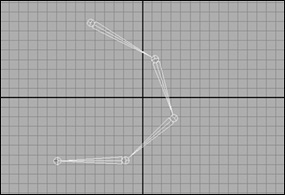
| 2. | From the Skeleton menu, select Insert Joint Tool.
| 3. | Click on a joint and drag out the new joint.
The new joint will be inserted between the joint you clicked and the joint beneath it in the hierarchy. It is easiest to do this in an orthographic view (Figure 10.18).
Figure 10.18. A new joint is created between two existing joints. It is positioned between the joints both physically and in the hierarchy. 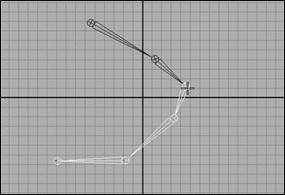
| 4. | Press  to finish, and exit the tool. to finish, and exit the tool.
|
Occasionally you may find that you've created more joints than you need. If so, you can select the joint and remove it from the hierarchy without deleting any additional nodes, like simply deleting the joint would do. To remove a joint from the hierarchy: 1. | Click the joint you would like to remove (Figure 10.19).
Figure 10.19. You can select a joint by clicking it in the modeling window, or by clicking the corresponding joint node in the Hypergraph. 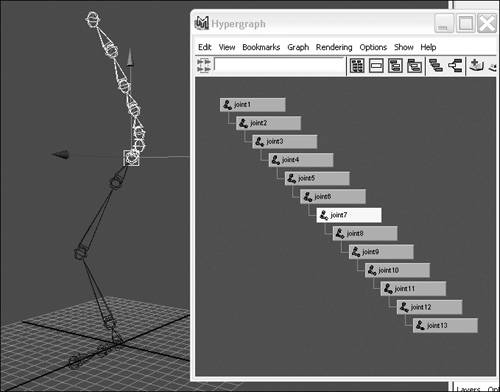
| 2. | From the Skeleton menu, select Remove Joint (Figure 10.20).
Figure 10.20. Select Remove Joint from the Skeleton menu. 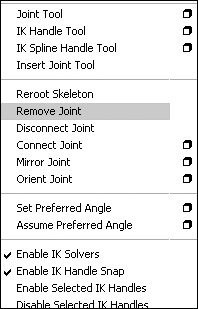
The joint is removed from the hierarchy and deleted from the scene. Now that the selected joint has been removed, the bone from its parent ends at the selected joint's child (Figure 10.21).
Figure 10.21. The selected joint (joint7) is now completely deleted from the scene and cannot be viewed in the Hypergraph. 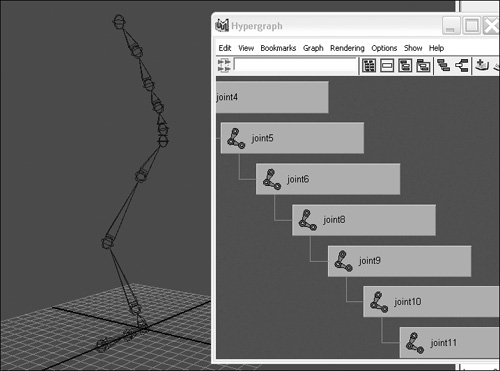
|
Sometimes you'll want to disconnect a portion of a previously created skeleton to use it in a new character. Say for a half-human character that uses a human joint systemwith human-like arms but nonhuman-like legs. By disconnecting the center joint, you could use the upper half of the human skeleton on the human half of the new character. To disconnect a joint from the hierarchy: 1. | Click the joint you would like to disconnect from the hierarchy (Figure 10.22).
Figure 10.22. You can select a joint by clicking on it in the modeling window, or by clicking the corresponding joint node in the Hypergraph. 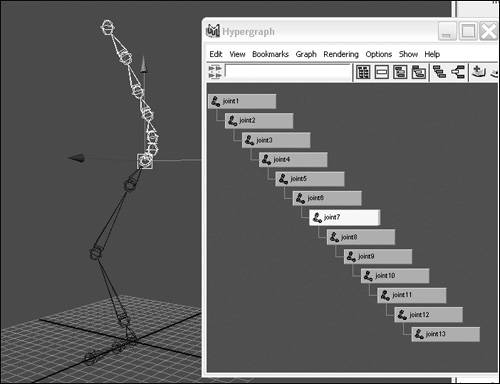
| 2. | From the Skeleton menu, select Disconnect Joint (Figure 10.23).
Figure 10.23. Select Disconnect Joint from the Skeleton menu. 
The selected joint and its children are disconnected from the original hierarchy.
| 3. | From the Window menu, select Hypergraph.
The Hypergraph opens in a new window.
| 4. | Press  to focus all of the joints in the Hypergraph window. to focus all of the joints in the Hypergraph window.
The skeleton is now split into two hierarchies that can be selected and moved independently of each other (Figure 10.24).
Figure 10.24. Although in the modeling view the skeleton still appears to be one, you can see in the Hypergaph that there are now two separate hierarchies. 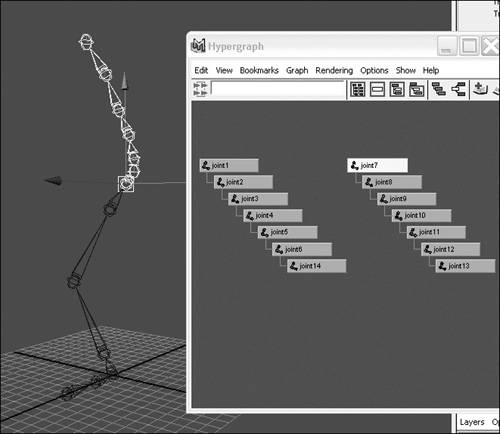
|
|


 Tips
Tips

















